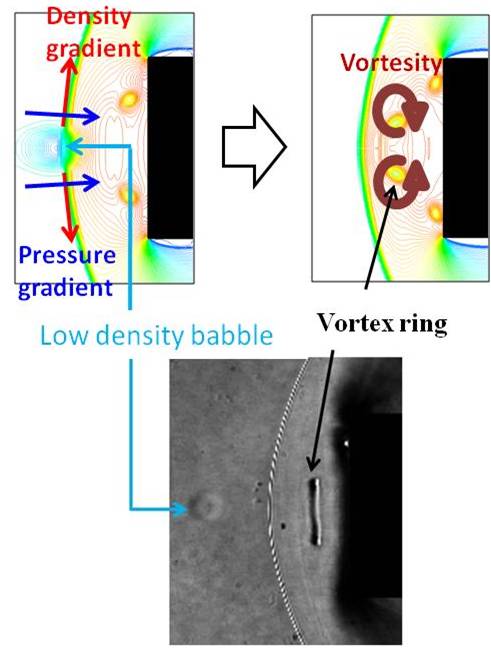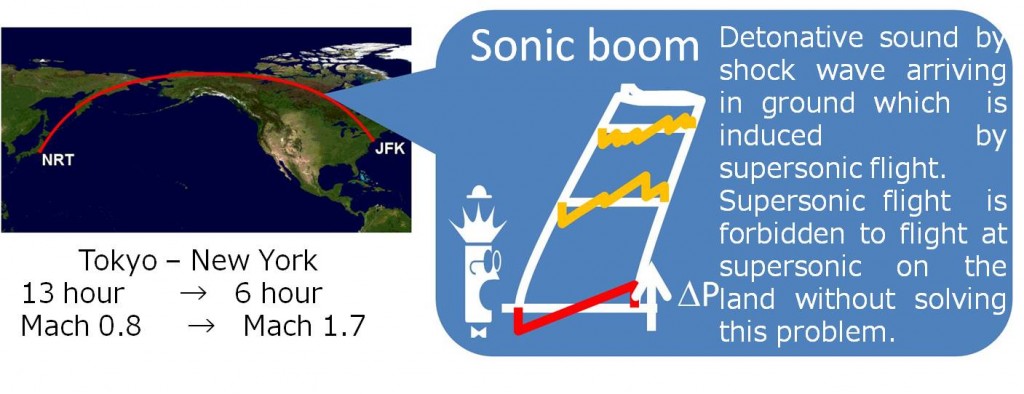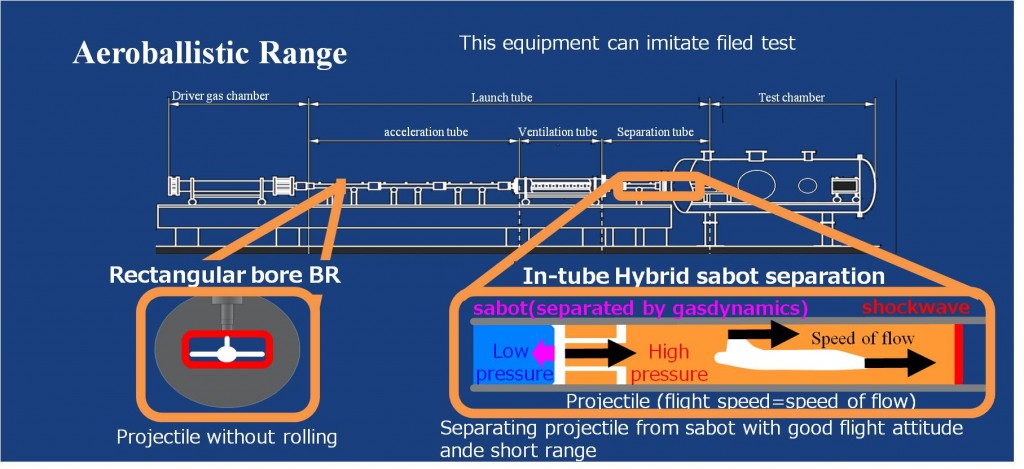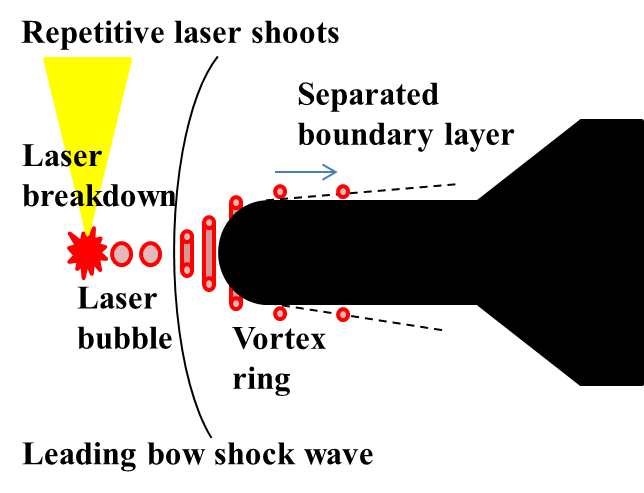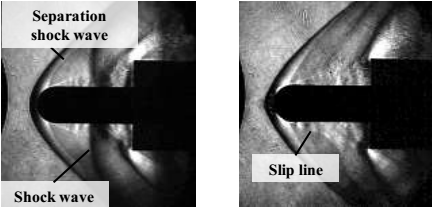Drag Reduction
About
The velocity which is faster than sound is called supersonic. The problem of the supersonic flight is its poor aerodynamic performance.
In order to solve this problem, it is proposed to heat air with laser. Our laboratory is researching on how to make more efficient supersonic flight by using this method.
About reserach
The goal of this investigation is to realize a commercial supersonic transportation which has not been operated after the abortion of Concorde. One major reason that led to the abortion of Concorde was its poor performance of fuel efficiency. The large wave drag caused by shock waves is occurred during supersonic flight. This drag does not exist during subsonic flight. This drag increment leads to worsen the fuel efficiency.
The objective of this investigation is to improve the aerodynamics performance of supersonic transportation by using the interaction between low density bubbles generated by repetitive laser pulses and shock waves. This method is called “Fly by Light Power(FBLP)” and we are approaching our reserach from two perspectives: experimental and numerical investigations.
Current outcome
The supersonic wind tunnel that we use for our experiment is designed by students in our laboratory(Fig.2). The test model is 20mm diameter cylinder. Bow shock made by Mach 1.94 flow and low density babble generated by laser irradiation interacts. This interaction makes bow shock moderate and creates vortex rings. This phenomena decreases the drag of the cylinder model about 20%, and the η(energy deposition efficiency) reached 10(Fig.3~5). From numerical simulation, it has been found that vortex rings generated by baroclinic effect have large effect on for drag reduction mechanism.
 |
 |
 Fig.5 energy deposition efficiency vs.input energy |
By increasing repetitive frequency of laser, more vortex rings stay in front of the test model . It creates the area which called ‘Virtual cone’(Fig.7). Virtual cone acts as cone attached in front of the cylinder test model. It makes bow shock attenuation. Consequently it reduces the drag.
blunt-cylinder body
0kHz laser energy deposition
80kHz laser energy deposition
Related Journal
- T. Sakai, Y. Sekiya, K. Mori, and A. Sasoh, Proceedings of the Institution of Mechanical Engineers, Vol. 222, Part G: Journal of Aerospace Engineering, pp. 605-617, 2008.
- Sakai,T,”Supersonic Drag Performance of Truncated Cones With Repetitive Energy Depositions “,The International Aerospace Innovation , Vol. 1, No. 1, pp. 31-43, 2009.
- Jae-Hyung Kim, Akihiro Sasoh and Atsushi Matsuda, Shock Waves, Vol. 20, pp.339-345, 2010.
- Jae-Hyung Kim, Atsushi Matsuda, Takeharu Sakai, Akihiro Sasoh, AIAA Journal, Vol. 49, No. 9, pp. 2706-2078, 2011.
- Jae-Hyung Kim, Atsushi Matsuda, Akihiro Sasoh, Physics of Fluids, Vol. 23, ArtID 021703,2011.
- Iwakawa A., Sakai T., Sasoh A., Transactions of the Japan Society for Aeronautical and Space Sciences, Aerospace Technology Japan, Vol. 11, pp.53-66, 2013.
- Sasoh S., Kim J. H., Yamashita K., and Sakai T, Shock Waves Vol. 24, No. 1, pp. 59-67, 2014.
- 岩川輝,大須賀健,摩嶋亮祐,酒井武治,佐宗章弘, 日本航空宇宙学会論文集,Vol. 62, pp. 99-106, 2014.
Sonic boom
About
Sonic Boom
When air planes flight at supersonic, shockwaves, expansion waves and other disturbances are induced. These are integrated in contagious process and the detonative sounds are observed on the ground. This phenomenon is called sonic boom. Because of the noise produced by sonic boom, supersonic flight is forbidden on the land. Therefore, reducing this noise is imperative to develop next generation supersonic transports.
Experiment with Ballistic Range
Sonic Boom reduction with staged aft body

Fig.3 Sonic Boom reduction with staged aft body
Using this characteristic, we could demonstrate the reduction of rear sonic boom by experiments.
Related Journal
- Akihiro Sasoh and Shin Oshiba, Review of Scientific Instruments, Vol. 77, No. 10, ArtID 105106, 2006.
- Sasoh Akihiro, Takahiro Imaizumi, Atsushi Toyoda, Takeshi Ooyama, AIAA Journal, Vol.53, No.9, pp. 2781-2784, 2015.
Shock Wave Boundary Layer Interaction
About
Shock wave and boundary layer Interaction (SWBLI) causes many serious problems to supersonic flight, such as unsteadiness of flow which leads to a decrease of engine performance, wing lift capacity and control surfaces effectiveness, as well as heat transfer and pressure loads which reduce the endurance of aircraft structures. To realize future supersonic transport, one of the important missions is to minimize negative impacts of SWBLI on supersonic vehicle.
Experimental approach
SWBLI was investigated by experimental approach. The hemisphere nose-cylinder-flare model configuration was used to study the interaction between the boundary layer of cylinder surface and the shock wave generated by flare part (Fig. 1). The adverse pressure from the flare-driven shock propagates upstream and leads to separated boundary layer as well as flow unsteadiness. Length of cylinder, angle and diameter of flare are changeable to achieve several of interaction states.
Fig. 1 SWBLI model configuration
Laser Energy Deposition (LED) method on flow control
In this study, we used LED as an active method to control the flow (Fig. 2). In detail, we took advantage of the low-density-bubble created by high repetitive laser pulses to suppress the separated boundary layer. By using LED, these bubbles interacted with the leading shock and transformed to vortex rings. In the next steps, the disturbance introduced by these rings induced the boundary layer transition so that it became “robust” against the adverse pressure gradient. Osuka et al. (2014).
Fig. 2 Boundary layer modification by LED method
Flow control by LED
Using high repetitive laser with frequency up to 60 kHz, the LED method shows its effectiveness in separation control in case of weak interaction, corresponding to small-flare-angle model (Fig. 3). Besides, in case of strong interaction, the LED method shows the ability to reduce oscillation of flow (Fig. 4). Future studies will focus on the low-frequency unsteadiness which plays an important role to the structure fatigue by resonant pressure load.
Fig. 3 Separation control
Fig. 4 Oscillation control
Related Journal
- T. Osuka, E. Erdem, N. Hasegawa, R. Majima, T. Tmaba, S. Yokota, A. Sasoh, K. Kontis, Shock Waves, Vol. 26, No. 9, ArtID 096103, 2014.
- T. Tamba, H. S. Pham, T. Shoda, A. Iwakawa, A. Sasoh, Physics of Fluid, Vol. 27, 091704, 2015.







